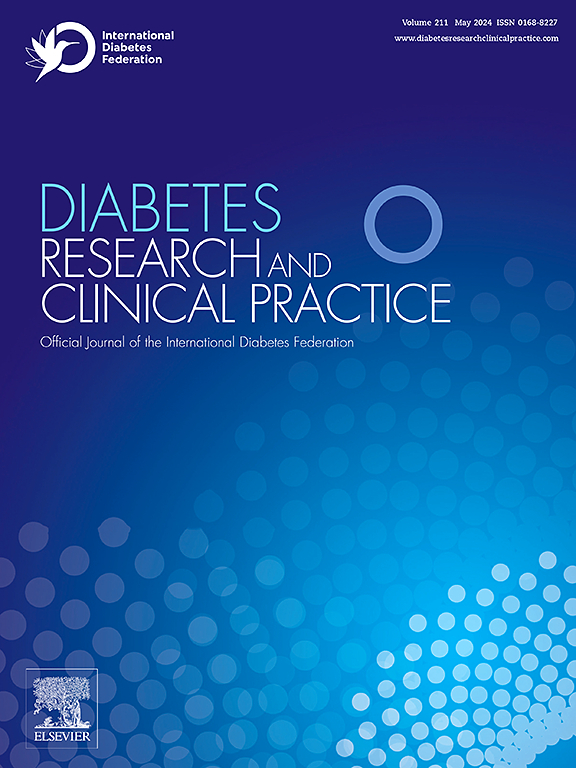肝脂肪变性与高血糖状态下肝脏葡萄糖摄取受损有关,这是一种动态全身18F-FDG PET方法
IF 6.1
3区 医学
Q1 ENDOCRINOLOGY & METABOLISM
引用次数: 0
摘要
肝脏脂肪堆积与肝脏胰岛素抵抗有关,胰岛素诱导的内源性葡萄糖生成(EGP)抑制降低就是证据。然而,EGP的抑制主要反映了胰岛素的间接作用。餐后状态下的肝脏葡萄糖摄取是肝脏胰岛素敏感性的另一个方面,很少被研究。在这里,我们试图检查肝脏脂肪变性是否与高血糖和高胰岛素血症条件下肝脏葡萄糖摄取减少有关。方法在这项横断面研究中,招募了15名经1h - mrs评估肝脏脂肪含量范围(0.9 - 18%)的参与者。全身胰岛素敏感性和胰岛素诱导的EGP抑制通过两步正糖-高胰岛素钳测定。采用动态全身18F-FDG PET方案,使用高血糖-高胰岛素钳测量肝脏和组织特异性葡萄糖摄取。结果在高血糖-高胰岛素血症条件下,肝脏葡萄糖摄取与肝脏脂肪含量呈显著负相关(r = -0.756, p <;0.001)。肝脏葡萄糖摄取也与胰岛素刺激的EGP抑制相关(r = 0.616, p = 0.015)。脂肪组织胰岛素敏感性与肝脏脂肪含量呈负相关,与肝脏、骨骼肌和脂肪组织葡萄糖摄取呈正相关。结论肝脏胰岛素抵抗的另一个方面,即胰岛素在高血糖状态下刺激肝脏葡萄糖摄取的能力,与肝脏脂肪含量呈负相关。这表明,肝脏葡萄糖摄取可能是代谢功能障碍相关脂肪变性肝病(MASLD)和2型糖尿病风险的另一个重要因素,需要进一步研究。本文章由计算机程序翻译,如有差异,请以英文原文为准。
Hepatic steatosis is associated with impaired hepatic glucose uptake under hyperglycemic conditions, a dynamic whole-body 18F-FDG PET approach
Objective
Accumulation of fat in the liver is associated with hepatic insulin resistance, as evidenced by a reduced insulin-induced suppression of endogenous glucose production (EGP). However, suppression of EGP has been proposed to be mainly a reflection of indirect insulin action.Hepatic glucose uptake in the postprandial state is another aspect of hepatic insulin sensitivity, which is seldom investigated. Here we sought to examine if hepatic steatosis is associated with a reduced hepatic glucose uptake under conditions of hyperglycemia and hyperinsulinemia.
Methods
In this cross-sectional study, 15 participants with a range of liver fat content (0.9–18 %) as assessed by 1H-MRSwere recruited. Whole-body insulin sensitivity and insulin-induced suppression of EGP were measured by a two-step euglycemic-hyperinsulinemic clamp. A hyperglycemic-hyperinsulinemic clamp was used to measure hepatic and tissue-specific glucose uptake using a dynamic whole-body 18F-FDG PET protocol.
Results
Under conditions of hyperglycemic-hyperinsulinemia, hepatic glucose uptake correlated strongly and inversely with liver fat content (r = -0.756, p < 0.001). Hepatic glucose uptake also correlated with insulin-stimulated EGP suppression (r = 0.616, p = 0.015). Adipose tissue insulin sensitivity was negatively associated with liver fat content and positively with hepatic, skeletal muscle, and adipose tissue glucose uptake.
Conclusion
We show that another aspect of hepatic insulin resistance, namely the ability of insulin to stimulate hepatic glucose uptake under hyperglycemic conditions, is negatively associated with hepatic fat content. This suggests that hepatic glucose uptake is another factor that may be important in Metabolic dysfunction Associated Steatotic Liver Disease (MASLD) and the risk for type 2 diabetes, and needs further investigation.
求助全文
通过发布文献求助,成功后即可免费获取论文全文。
去求助
来源期刊

Diabetes research and clinical practice
医学-内分泌学与代谢
CiteScore
10.30
自引率
3.90%
发文量
862
审稿时长
32 days
期刊介绍:
Diabetes Research and Clinical Practice is an international journal for health-care providers and clinically oriented researchers that publishes high-quality original research articles and expert reviews in diabetes and related areas. The role of the journal is to provide a venue for dissemination of knowledge and discussion of topics related to diabetes clinical research and patient care. Topics of focus include translational science, genetics, immunology, nutrition, psychosocial research, epidemiology, prevention, socio-economic research, complications, new treatments, technologies and therapy.
 求助内容:
求助内容: 应助结果提醒方式:
应助结果提醒方式:


